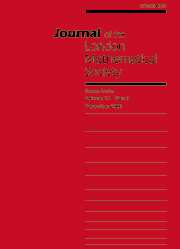Article contents
MINIMAL REPRESENTATIONS OF LOCALLY PROJECTIVE AMALGAMS
Published online by Cambridge University Press: 23 July 2004
Abstract
A locally projective amalgam is formed by the stabilizer $G(x)$ of a vertex $x$ and the global stabilizer $G\{x,y\}$ of an edge containing $x$ in a group $G$, acting faithfully and locally finitely on a connected graph $\Gm$ of valency $2^n\,{-}\,1$ so that (i) the action is 2-arc-transitive, (ii) the sub-constituent $G(x)^{\Gm(x)}$ is the linear group ${\rm SL}_n(2) \,{\cong}\, {\rm L}_n(2)$ in its natural doubly transitive action, and (iii) $[t,G\{x,y\}] \,{\le}\, O_2(G(x) \,{\cap}\, G\{x,y\})$ for some $t \,{\in}\, G\{x,y\} \setminus G(x)$. Djoković and Miller used the classical Tutte theorem to show that there are seven locally projective amalgams for $n\,{=}\,2$. Trofimov's theorem was used by the first author and Shpectorov to extend the classification to the case $n \,{\ge}\, 3$. It turned out that for $n\,{\geq}\,3$, besides two infinite series of locally projective amalgams (embedded into the groups ${\rm AGL}_n(2)$ and $O_{2n}^+(2)$), there are exactly twelve exceptional ones. Some of the exceptional amalgams are embedded into sporadic simple groups $M_{22}$, $M_{23}$, $Co_2$, $J_4$ and $\hbox{\it BM}$. For a locally projective amalgam $\cA$, the minimal degree $m\,{=}\,m(\cA)$ of its complex representation (which is a faithful completion into ${\rm GL}_m(\CC)$) is calculated. The minimal representations are analysed and three open questions on exceptional locally projective amalgams are answered. It is shown that
$\cA_4^{(1)}$ possesses ${\rm SL}_{20}(13)$ as a faithful completion in which the third geometric subgroup is improper;
$\cA_4^{(2)}$ possesses the alternating group ${\rm Alt}_{64}$ as a completion constrained at levels 2 and 3;
$\cA_4^{(5)}$ possesses ${\rm Alt}_{256}$ as a completion which is constrained at level 2 but not at level 3.
Information
- Type
- Notes and Papers
- Information
- Copyright
- The London Mathematical Society 2004
- 3
- Cited by

